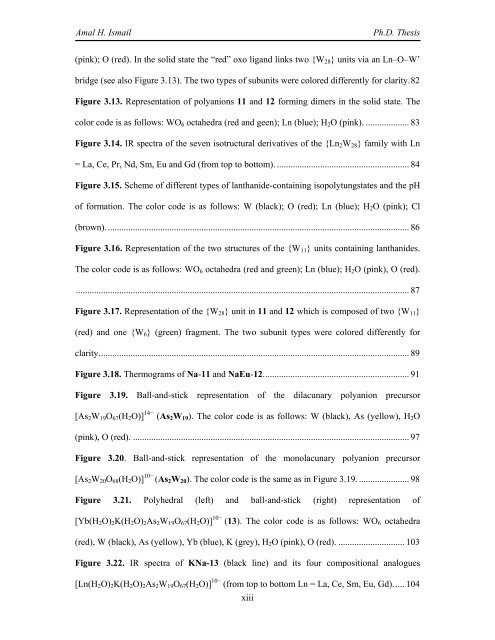Synthesis and Structural Characterization of ... - Jacobs University
Synthesis and Structural Characterization of ... - Jacobs University
Synthesis and Structural Characterization of ... - Jacobs University
Create successful ePaper yourself
Turn your PDF publications into a flip-book with our unique Google optimized e-Paper software.
Amal H. Ismail<br />
Ph.D. Thesis<br />
(pink); O (red). In the solid state the “red” oxo lig<strong>and</strong> links two {W 28 } units via an Ln–O–W’<br />
bridge (see also Figure 3.13). The two types <strong>of</strong> subunits were colored differently for clarity. 82<br />
Figure 3.13. Representation <strong>of</strong> polyanions 11 <strong>and</strong> 12 forming dimers in the solid state. The<br />
color code is as follows: WO 6 octahedra (red <strong>and</strong> geen); Ln (blue); H 2 O (pink). ................... 83<br />
Figure 3.14. IR spectra <strong>of</strong> the seven isotructural derivatives <strong>of</strong> the {Ln 2 W 28 } family with Ln<br />
= La, Ce, Pr, Nd, Sm, Eu <strong>and</strong> Gd (from top to bottom). .......................................................... 84<br />
Figure 3.15. Scheme <strong>of</strong> different types <strong>of</strong> lanthanide-containing isopolytungstates <strong>and</strong> the pH<br />
<strong>of</strong> formation. The color code is as follows: W (black); O (red); Ln (blue); H 2 O (pink); Cl<br />
(brown)..................................................................................................................................... 86<br />
Figure 3.16. Representation <strong>of</strong> the two structures <strong>of</strong> the {W 11 } units containing lanthanides.<br />
The color code is as follows: WO 6 octahedra (red <strong>and</strong> green); Ln (blue); H 2 O (pink), O (red).<br />
.................................................................................................................................................. 87<br />
Figure 3.17. Representation <strong>of</strong> the {W 28 } unit in 11 <strong>and</strong> 12 which is composed <strong>of</strong> two {W 11 }<br />
(red) <strong>and</strong> one {W 6 } (green) fragment. The two subunit types were colored differently for<br />
clarity. ....................................................................................................................................... 89<br />
Figure 3.18. Thermograms <strong>of</strong> Na-11 <strong>and</strong> NaEu-12. ............................................................... 91<br />
Figure 3.19. Ball-<strong>and</strong>-stick representation <strong>of</strong> the dilacunary polyanion precursor<br />
[As 2 W 19 O 67 (H 2 O)] 14− (As 2 W 19 ). The color code is as follows: W (black), As (yellow), H 2 O<br />
(pink), O (red). ......................................................................................................................... 97<br />
Figure 3.20. Ball-<strong>and</strong>-stick representation <strong>of</strong> the monolacunary polyanion precursor<br />
[As 2 W 20 O 68 (H 2 O)] 10− (As 2 W 20 ). The color code is the same as in Figure 3.19. ...................... 98<br />
Figure 3.21. Polyhedral (left) <strong>and</strong> ball-<strong>and</strong>-stick (right) representation <strong>of</strong><br />
[Yb(H 2 O) 2 K(H 2 O) 2 As 2 W 19 O 67 (H 2 O)] 10− (13). The color code is as follows: WO 6 octahedra<br />
(red), W (black), As (yellow), Yb (blue), K (grey), H 2 O (pink), O (red). ............................. 103<br />
Figure 3.22. IR spectra <strong>of</strong> KNa-13 (black line) <strong>and</strong> its four compositional analogues<br />
[Ln(H 2 O) 2 K(H 2 O) 2 As 2 W 19 O 67 (H 2 O)] 10− (from top to bottom Ln = La, Ce, Sm, Eu, Gd). .... 104<br />
xiii

















